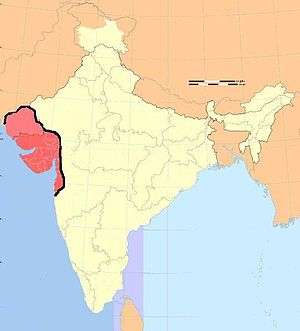Aparanta
Aparanta, or Aparantaka (meaning "Western border") was a geographical region of ancient India, variously corresponding to the northern Konkan, northern Gujarat, Kathiawar, Kachch and Sindh.

The Junagadh inscription of Rudradaman mentions that during Ashoka's reign, a Yonaraja (literally; Ionian, or Greek, King), Tushaspa was the governor of Aparanta.[1] A Buddhist text, the Mahavamsa states (xii.5) that at the conclusion of the Third Buddhist Council (c.250 BCE), a Yona (Greek) Thera (monk) Dhammarakkhita was sent here by the emperor Ashoka to preach Dhamma[2] and 37,000 people embraced Buddhism due to his effort (Mahavamsa, xii.34-6). According to Buddhist scholar A.K. Warder, the Dharmaguptaka sect originated here.[3]
Aparanta is regarded as an umbrella term for Shurparakadesha for Konkan, to include in the North and Gomantaka in the south with the river Kundalika to serving as a dividing line in between the two.[4]
Notes
- ↑ Thapar R. (2001), Aśoka and the Decline of the Mauryas, Oxford University Press, New Delhi, ISBN 0-19-564445-X, p.128
- ↑ Thapar R. (2001), Aśoka and the Decline of the Mauryas, Oxford University Press, New Delhi, ISBN 0-19-564445-X, p.47
- ↑ Indian Buddhism by A.K. Warder Motilal Banarsidass: 2000. ISBN 81-208-1741-9 pg 278
- ↑ Kamat Satoskar, B.D. (1982). Gomantak:Prakruti ani Sanskruti(Marathi). Pune: Shubhada publications. p. 39.